Abstract
We show that the so-called motorcycle graph of a planar polygon can be constructed by a randomized incremental algorithm that is simple and experimentally fast. Various test data are given, and a clustering method for speeding up the construction is proposed.
1. Introduction
The so-called straight skeleton is an internal tree structure for polygons. It is used in computational geometry and also in other fields of science [1] as a piecewise-linear alternative to the (potentially curved) medial axis of a polygon. The straight skeleton is defined by a mitered offsetting process, where the boundary of the polygon gets moved inwards in a self-parallel manner. Thereby, the polygon edges change in length and eventually shrink to length zero and disappear, and the shrinking polygon may split at various places. During the offsetting process, the vertices of the polygon move on internal angle bisectors and trace out certain straight-line segments in the polygon’s interior that build up a tree structure—the straight skeleton.
The reflex vertices of the polygon (i.e., those having an internal angle larger than ) play a special role in the construction of the straight skeleton. The reason is that such vertices are responsible for possible polygon splits, which are non-local events and therefore are (unlike the disappearances of edges) costly to predict. The problem of dissolving the interaction of the reflex polygon vertices was abstracted by Eppstein et al. [2] into a separate problem which they called the motorcycle graph problem. Figure 1 and Figure 2 give an example and explanations. Consider r ’motorcycles’ starting from r given points in the plane (the reflex polygon vertices), at different but constant speeds (given by the interior polygon angles) and in different directions (following the respective angle bisectors). Each motorcycle produces a trace where other motorcycles, when running into it, crash and end their movement. The collection of all the motorcycle traces now define the motorcycle graph of the polygon.
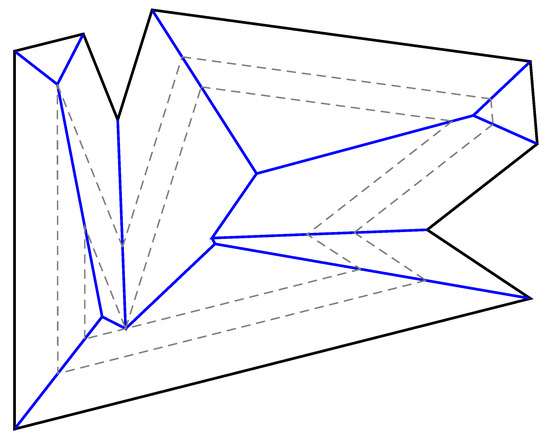
Figure 1.
Straight skeleton of a polygon. The dashed polygon offsets indicate its shrinking process.
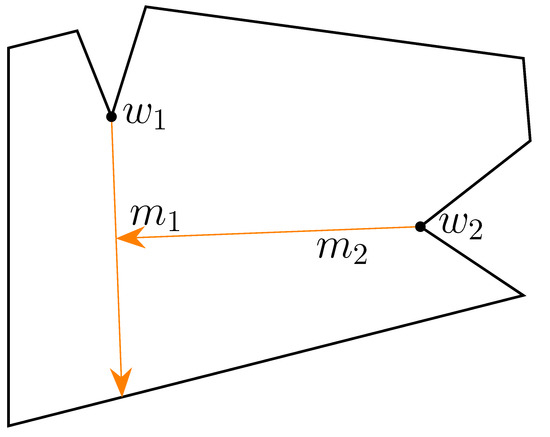
Figure 2.
The corresponding motorcycle graph is defined by two motorcycles, and , that start at the reflex vertices and , respectively.
Computing the straight skeleton or at least the motorcycle graph efficiently has been a topic in computational geometry over the years; see e.g., [2,3,4,5]. Indeed, precomputing the motorcycle graph lead to the first straight skeleton algorithm with sub-quadratic runtime. Typically, the behaviour of the motorcycles is tracked over time, handling all motorcycles simultaneously—the simplest algorithm just computing all the intersections between traces beforehand.
The goal of the present paper is to show that treating the motorcycles individually (rather than simultaneously) leads to a simple and practical algorithm. We will apply randomized insertion to the motorcycles and maintain a partial motorcycle graph during this process. Our empirical results indicate competitiveness of our new method to other implemented algorithms like in [6]. A conference version of this paper appeared in [7].
2. Insertion Algorithm
2.1. Preliminaries
In this work, is always a simple polygon with n vertices, denoting its boundary. Let be the subset of all the reflex vertices of , in some fixed order. With each such reflex vertex we associate a constant velocity . (In the context of the straight skeleton of the polygon , this velocity is defined as the speed and direction of during the shrinking process of ). Furthermore, let be the motorcycle moving from with velocity . Then at time , the motorcycle is located at . We assume that leaves behind a straight trace, and when reaches the trace of another motorcycle or the polygon boundary at some time t, then is said to crash: That is, for all , the position of remains at . The union of all motorcycle traces generated in this way is called the motorcycle graph of W, or for short.
2.2. Localized Intersection Computations
In [4] Cheng and Vigneron introduced a partition of the polygon (or more generally, of the entire plane) into convex cells, in order to reduce the number of intersection computations between motorcycle traces. The positions of the motorcycles are tracked over time, and intersections are only computed among motorcycle traces that are ‘active’ within the same cell. A motorcycle is called active in a cell C at time t when it was located within C for some time . The set of active motorcycles is tracked for each cell as a local arrangement of line segments , initialized to the empty set at the start of the algorithm. If a motorcycle m crashes at some time t, its ‘death time’ is recorded as ; initially is set to ∞, and m is called alive if it has not crashed yet. To track the state of the motorcycles over time, three kinds of events are processed: collision events (two motorcycle traces intersect within a cell; these events are called impact events in [4]), switch events (a motorcycle crosses the cell boundary to enter the next cell), and boundary events (the motorcycle crashes into the polygon boundary; these events are not considered in [4] because the motorcycles are not restricted to a polygon there). The events are managed by a time-ordered queue , initialized with switch events taking each motorcycle to its starting cell (i.e., the cell adjacent to the reflex polygon vertex where the motorcycle starts). The events are processed in the following way:
- Boundary
- event of motorcycle m at time t, where m crashes into at some point q. If m is alive at t, the motorcycle edge is reported. In addition, we put . If m was already dead at time t there is nothing to do.
- Collision
- event of motorcycle m at time t, where m reaches the trace of another motorcycle at point q, with having tentatively passed q at some time . If (m has already crashed) or if ( has crashed before reaching q), then there is nothing to do. Otherwise m crashes at q, and so we set .
- Switch
- event of motorcycle m at time t, moving from cell C to cell . If there is nothing to do. Otherwise the line segment representing the (tentative) track of m through is inserted into the arrangement . Collision events of m with other motorcycles in are computed via and are inserted into the queue . (Note that collision events between two motorcycles are always associated with the motorcycle reaching the collision point last). Also, the next switch event for m, passing from to the next cell , is computed and inserted into . If there is no such cell , i.e., when m crashes into , then the corresponding boundary event is inserted into .
The running time of this algorithm is largely dependent on the chosen cell partition. By using an cutting, Cheng and Vigneron achieve a running time of . They also present a simpler randomized approach: choose randomly motorcycles, and use the arrangement of the support lines defined by the chosen motorcycles as the partition. This results in an expected running time of . A slight variation of this idea has been used in an implementation by Huber and Held in [6], where they partition the plane using a times rectangular grid.
Common to these approaches is the simulateneous processing of all motorcycles over time. By contrast, we shall consider each motorcycle at a time: We devise an insertion algorithm for the motorcycles, which is based on a cell partition different from the ones used before, and which is described below.
2.3. Motorcycle Insertion
Let be a subset of the reflex vertices of , and let be the partial motorcycle graph, where only the motorcycles of the vertices in move. In this section we show how the next motorcycle, , can be inserted into in order to obtain .
In the simplest case, crashes at or at the first motorcycle trace in that it reaches. Then we only need to add the motorcycle edge of to to obtain . Otherwise, the insertion of causes more complex structural changes. In the worst case, all the edges of can change, meaning that they either get shortened or extended in .
To compute these changes, we adapt the algorithm from [4]. However, we use the (already computed) partial motorcycle graph as our cell partition of . Initially, there is only one moving motorcycle, . is initialized with a single event, the switch event for when it enters the cell adjacent to . As cell boundaries correspond to motorcycle traces, switch and collision events can happen at the same time; in such a case the collision event is processed first. The event processing is adapted in the following way:
- Boundary
- events are handled as before.
- Collision
- event of motorcycle m at time t, reaching the trace of motorcycle at point q, with having tentatively passed q at some time . This is handled as before, and in case both motorcycles are alive at q (i.e., m actually crashes at q) and , then we additionally need to ‘activate’ all motorcycles that got blocked by m (after m passed q) and that have . See Figure 3 and Figure 4 for illustrations. For all such motorcycles we do the following: Put , and insert into a switch event of crossing the edge defined by m to reach the next cell, say . (This switch event will then add to .)
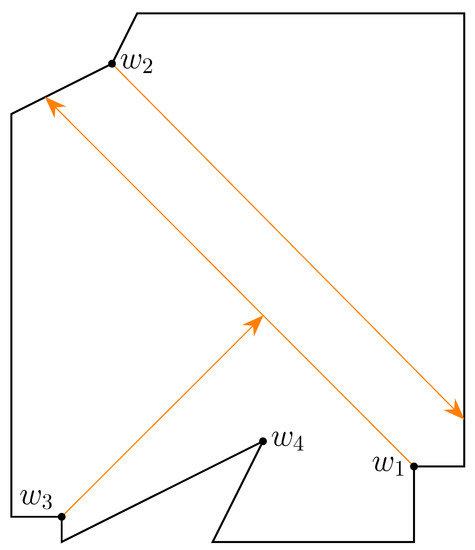 Figure 3. Partial motorcycle graph before the insertion of motorcycle .
Figure 3. Partial motorcycle graph before the insertion of motorcycle .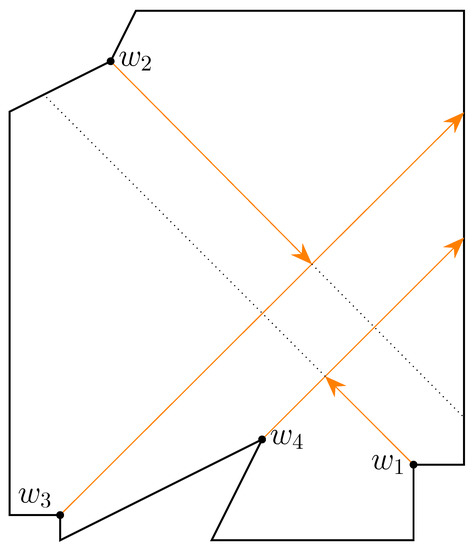 Figure 4. Insertion of makes crash. This activates which is now blocking .
Figure 4. Insertion of makes crash. This activates which is now blocking . - Switch
- events are handled as before.
Theorem 1.
The motorcycle insertion algorithm is correct.
Proof.
Correctness of our approach mainly follows from the correctness of the Cheng-Vigneron algorithm [4]. The only difference is that our algorithm avoids creating and processing certain events because is used as the underlying polygon partition.
Consider all collision events for the motorcycle graph , as well as all the switch events for the motorcycles . These events are precomputed in [4], as opposed to our on-demand approach. Our algorithm processes the same events, except that we need not process the collision events for because we already know the result of these events (namely, itself)—if these events are relevant at all (motorcycles may crash earlier in ). Also, computing switch events on demand—when a motorcycle enters a new cell—for and for the unblocked motorcycles of changes neither the events nor their processing. Thus, our algorithm and the algorithm of [4] produce the same result. □
Clearly, the final result of our algorithms does not depend on the order in which the motorcycles are inserted. While intermediate results (i.e., the partial motorcycle graphs ) might be different, the algorithm always ends up with constructing . We will exploit this fact and will insert the motorcycles in random order to reduce the running time in the expected case.
2.4. Partition Maintenance
So far we discussed the insertion of a single motorcycle into to compute , but to obtain an algorithm for incrementally constructing the motorcycle graph we need to maintain the partial motorcycle graph during the insertion steps. From to existing motorcycle edges can be shortened or extended. Shortening an edge causes two adjacent cells to be merged, extending an edge causes a cell to be split (see Figure 5 for an illustration). During the event processing, the algorithm needs to compute switch and boundary events—this can be done by using ray shooting queries within cells. And when inserting a new motorcycle it is necessary to find the adjacent cell of for the initial switch event.

Figure 5.
Updating the cell structure of the motorcycle graph.
The data structure from Goodrich and Tamassia [8] supports all needed operations in time using space. In practice, if costly operations do not occur too often, it may be efficient enough to organize in a doubly-connected edge list data structure, and to do simple boundary scans for all operations (see the Section 3 for data supporting this approach). Also note that, while the cells of are in general not convex, they can be treated as such for in-cell ray shooting queries: Figure 6 explains how a cell can be extended to a convex cell for this purpose.
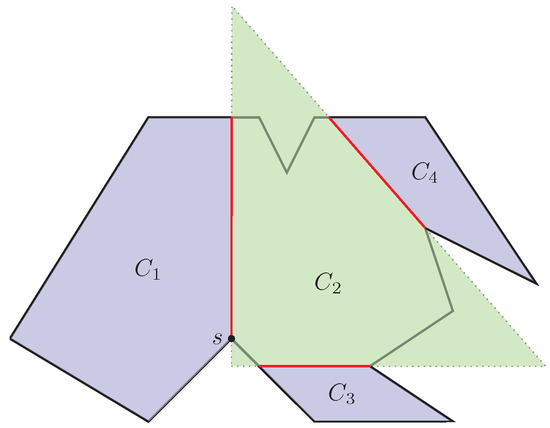
Figure 6.
Motorcycle cells ( to ) induce (possibly infinite) convex polygons by extending their bordering motorcycle edge segments. (The green area shows the induced polygon for the cell .).
3. Experimental Results
Analysing our insertion step, we can observe that structural changes can happen from to . This basically amounts to a complete recomputation of the partial motorcycle graph. Figure 7 gives an example. Assuming this worst case for all iterations, we end up with a running time that is a factor of n worse than the algorithm from [4].
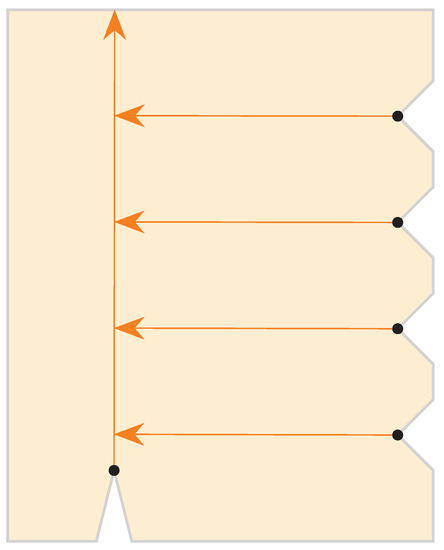
Figure 7.
The insertion of one motorcycle can block all the others.
The construction given in Figure 8 has as many as structural changes in the last insertion step, averaged over all reflex vertices. This shows that, even when using randomized insertion, the expected runtime of a single step can be as large as . As a consequence, applying the backwards analysis technique for randomized incremental insertion (as in [9]) does not provide any improved runtime bounds.

Figure 8.
Polygon angles can be adjusted such that removal of any of the blue motorcycles unblocks its associated red motorcycle, which in turn blocks the green motorcycles.
Deriving theoretical bounds on the expected overall runtime thus seems to be intricate, and we instead explored the practical performance of our randomized insertion algorithm on large sets of polygons of different shapes and characteristics. We observed the occurring number of structural changes—for each already inserted motorcycle a modification counter for its associated edge in the partial motorcycle graph is maintained.
The polygons considered can be divided into three categories: Random polygons from the Salzburg Database of Geometric Inputs [10] (like in Figure 9), polygonal country outlines taken from Natural Earth [11] and DIVA-GIS [12] (see Figure 10 for examples), and specifically constructed polygons (see Figure 8 and Figure 11). Many more details on the used data and their exploration can be found in Ladurner’s Master thesis [13].

Figure 9.
Examples of random polygons from Salzburg Database of Geometric Inputs [10].

Figure 10.
Examples of country-based polygons from Natural Earth [11].
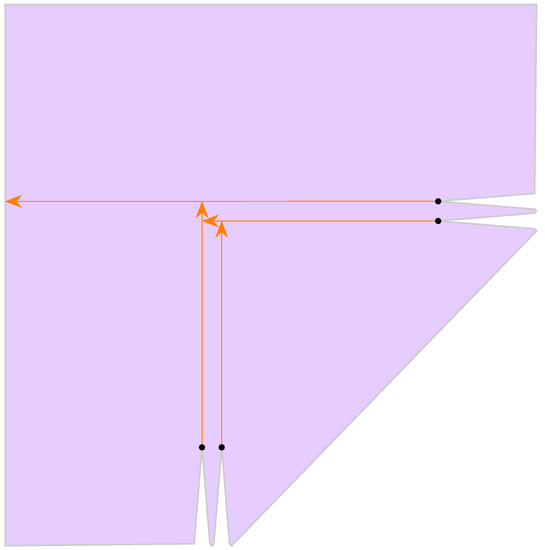
Figure 11.
Polygon with motorcycle intersections.
For each of the tested polygons without exception, the following interesting and encouraging fact could be observed: The number of structural changes, averaged over all insertion steps, is bounded by a small constant. The plots in Figure 12 and Figure 13 give some details. We conclude that in practice our randomized insertion algorithm performs very well; structural changes per insertion leads to an expected overall running time of .
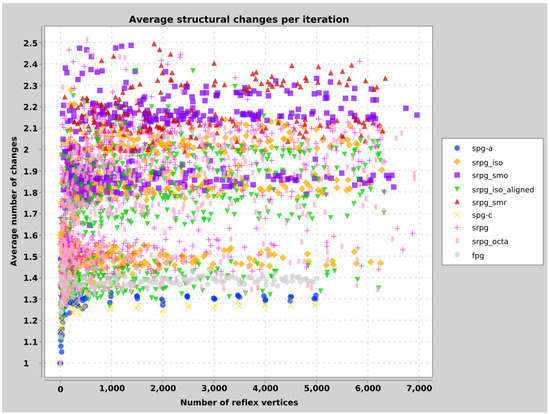
Figure 12.
Average number of structural changes per insertion step. (For polygons from [10] with up to 7000 reflex vertices).
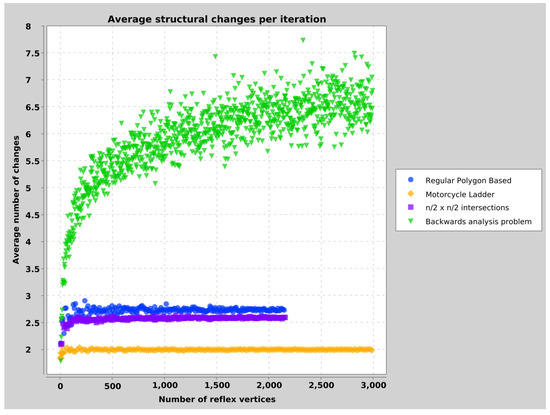
Figure 13.
Average number of structural changes per insertion step, for specifically constructed polygons.
4. Structural Aspects
In this section we take a closer look at a structural property of polygons that has a direct impact on the performance of our insertion algorithm.
The most challenging configuration for the insertion algorithm is when all motorcycles of a polygon interact with each other, that is, when there are intersections among motorcycle traces to consider. However, for many types of polygons this will not be the case. The set of motorcycles then can be divided into subsets that can be processed independently by the insertion algorithm. If the sizes of these subsets are sufficiently small, much better theoretical running times can be achieved. In particular, for constant sizes a running time of is obtained.
4.1. Motorcycle Crews
Let us formalize the notion of interacting motorcycles. For this purpose we represent each motorcycle by a pair of its starting point and its potential crashing point on the polygon boundary . Since we are only interested in whether these potential traces have intersection points within , we can simply model by a disk and the traces by arcs within this disk. See Figure 14 for an example.
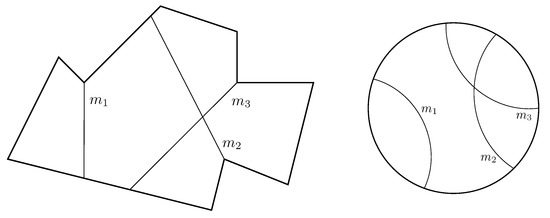
Figure 14.
Polygon with motorcycles (left) and its abstraction on a disk (right).
In this way we obtain what is called the model of a circle graph (or chord intersection graph) in graph theory [14]. We are interested in the connected components of this graph, which we shall call motorcycle crews in our context. Each motorcycle crew can be processed independently by our insertion algorithm.
To compute these crews, we perform a counterclockwise walk along from an arbitrary initial point. A list is kept containing all currently encountered but not yet completed crews. When the starting point p of a motorcycle trace is encountered, we add it to and assign this motorcycle to a new crew. When the endpoint q of a trace is encountered, we locate its starting point p in and merge all motorcycles between p and q into a common crew. If this crew is complete (meaning that each member has both its starting and its endpoint in ), the crew is reported and removed from . Note that can be implemented as a union-find data structure [15], such that all necessary operations can be carried out in overall time.
4.2. Experimental Data
The algorithm for computing the motorcycle crews has been run on polygons with up to 30.000 vertices from the Salzburg Database of Geometric Inputs [10], as well as on polygons based on country outlines taken from Natural Earth [11] and DIVA-GIS [12].
Figure 15 shows the distribution of crew sizes in relation to the number of reflex vertices of a polygon. The smallest crew sizes strongly dominate all the others combined (a), which promises a speed-up of our insertion algorithm for most instances. A closer look at the remaining crew sizes (b) shows that there are a few hundred polygons (out of around 2700) that have one very large crew containing almost all motorcycles. For these polygons our insertion algorithm does not get a benefit for processing crews separately. For polygons based on country outlines the situation is less favorable; see Figure 16. Most polygons have crews of size , that is, most motorcycles interact with each other.
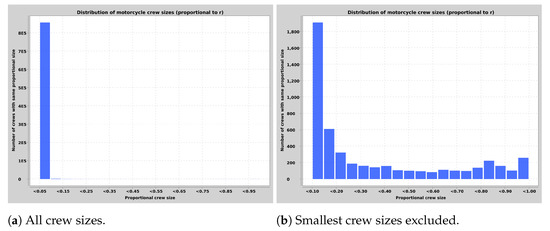
Figure 15.
Histogram of motorcycle crew sizes in relation to the number of reflex vertices. Data for 2700 polygons with at least 100 reflex vertices from Salzburg Database of Geometric Inputs [10].

Figure 16.
Histogram of motorcycle crew sizes in relation to the number of reflex vertices. Data for 380 country outline based polygons with at least 100 reflex vertices from Natural Earth [11] and DIVA-GIS [12].
5. Conclusions
In summary, the insertion strategy enables a quick and simple construction of motorcycle graphs in practice. Together with the simple motorcycle-graph-based skeleton merging algorithm in [16], we obtain a new practical method for computing straight skeletons.
Author Contributions
Algorithm idea and initial design: M.S.; Algorithm refinement and article writing (including reviewing and editing): F.A. and M.S.; designing, implementing and executing tests on polygons: C.L. and M.S. All authors have read and agreed to the published version of the manuscript.
Funding
This research was supported by Project I 5270-N, Austrian Science Fund (FWF).
Data Availability Statement
Source code used in the practical part of this work can be found in the following Git repositories (all accessed on 6 May 2022): https://github.com/utnapischtim/motorcycle-graph, https://github.com/utnapischtim/sui, https://github.com/utnapischtim/qui, https://github.com/utnapischtim/otu. Analyzed data sets (polygons) are available at [10,11,12].
Acknowledgments
We thank the Computational Geometry and Applications Lab of the Department of Computer Science of the University of Salzburg for their database of geometric inputs [10].
Conflicts of Interest
The authors declare no conflict of interest.
References
- Aurenhammer, F.; Klein, R.; Lee, D.T. Voronoi Diagrams and Delaunay Triangulations; World Scientific: Singapore, 2013. [Google Scholar]
- Eppstein, D.; Erickson, J. Raising roofs, crashing cycles, and playing pool: Applications of a data structure for finding pairwise interactions. Discrete Comput. Geom. 1999, 22, 569–592. [Google Scholar] [CrossRef]
- Cheng, S.W.; Mencel, L.; Vigneron, A. A Faster Algorithm for Computing Straight Skeletons. ACM Trans. Algorithms 2016, 12, 1–21. [Google Scholar] [CrossRef]
- Cheng, S.W.; Vigneron, A. Motorcycle graphs and straight skeletons. Algorithmica 2007, 47, 159–182. [Google Scholar] [CrossRef]
- Vigneron, A.; Yan, L. A faster algorithm for computing motorcycle graphs. Discrete Comput. Geom. 2014, 52, 492–514. [Google Scholar] [CrossRef][Green Version]
- Huber, S.; Held, M. Motorcycle graphs: Stochastic properties motivate an efficient yet simple implementation. J. Exp. Algorithmics 2011, 16, 1. [Google Scholar] [CrossRef]
- Aurenhammer, F.; Steinkogler, M. An insertion strategy for motorcycle graphs. In Proceedings of the 38th European Workshop on Computational Geometry, Perugia, PG, Italy, 14–16 March 2022. [Google Scholar]
- Goodrich, M.; Tamassia, R. Dynamic ray shooting and shortest paths in planar subdivisions via balanced geodesic triangulations. J. Algorithms 1997, 23, 51–73. [Google Scholar] [CrossRef]
- Seidel, R. Backwards Analysis of Randomized Geometric Algorithms. In New Trends in Discrete and Computational Geometrys; Pach, J., Ed.; Springer: Berlin, Germany, 1993. [Google Scholar]
- Eder, G.; Held, M.; Jasonarson, S.; Mayer, P.; Palfrader, P. Salzburg Database of Polygonal Data: Polygons and Their Generators. Data Brief 2020, 31, 105984. [Google Scholar] [CrossRef] [PubMed]
- Natural Earth. Free Vector and Raster Map Data. Available online: https://www.naturalearthdata.com/ (accessed on 6 May 2022).
- DIVA-GIS. Free Spatial Data. Available online: https://www.diva-gis.org/Data (accessed on 6 May 2022).
- Ladurner, C. On the Incremental Construction of Motorcycle Graphs. Master’s Thesis, Graz University of Technology, Graz, Austria, 2022. [Google Scholar]
- Golumbic, M. Algorithm Graph Theory and Perfect Graphs; Academic Press: New York, NY, USA, 1980. [Google Scholar]
- Cormen, T.; Leiserson, C.; Rivest, R.; Stein, C. Introduction to Algorithms, 3rd ed.; MIT Press: Cambridge, MA, USA, 2009. [Google Scholar]
- Aurenhammer, F.; Steinkogler, M. On merging straight skeletons. In Proceedings of the 34th European Workshop on Computational Geometry, Berlin, Germany, 21–23 March 2018. [Google Scholar]
Publisher’s Note: MDPI stays neutral with regard to jurisdictional claims in published maps and institutional affiliations. |
© 2022 by the authors. Licensee MDPI, Basel, Switzerland. This article is an open access article distributed under the terms and conditions of the Creative Commons Attribution (CC BY) license (https://creativecommons.org/licenses/by/4.0/).